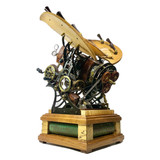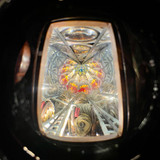Product Details
"Pegascoptylus" is a ONE OF A KIND (collectors ALERT), truly spectacular, Steampunk parlor kaleidoscope by American (Montana) kaleidoscope master and artist Steven Gray (retired). This incredible, moving, Steampunk sculpture not only gives you the mesmerizing fun of gazing into a wicked cool kaleidoscope, it also has (viewable inside and out) gears and cams moving up and down while you turn the hand cranks on the piece, but wait there's more, ... it also literally FLAPS ITS WINGS. This museum worthy, mechanical masterpiece will spellbind all that explore it's delightful possibilities. Signed (Steven Gray), titled (Pegascoptylus), and dated (2015) by the artist.
DETAILS:
- This scope has a converging 2-mirror system. The use of this mirror configuration provides many spaces for images as it has four different planes or windows interacting with the mirror system. The top viewing port is brass with a filigree pattern cut into it. Included is a set of magnetically removable extra lenses, including mild magnification, extreme magnification, and reducing lenses. Place these extra lenses over viewing ports for alternate scoping fun.
- There are two LED lighting systems with touch activated switches, dimmable by holding your finger on the buttons. Both will illuminate the genuine Quartz Crystal sphere on the base as mood lighting, while one button also turns on a set of lights that illuminate the items and moving gears on the inside of the mirrors and the second illuminates the rotating, turning, custom lamp work glass and oil-filled, triple, acrylic object cells. Exterior lighting can also be used to light up the image or enhance the LED lighting. Additionally, a set of lights under the large viewing window can be rotated to change the light direction, giving the illumination inside different effects.
- The turning hand crank facing the viewer runs most of the pieces mechanisms. With a turn of this crank, two sets of chains and sprockets are set in motion, one going to the kaleido-imagery and the other going to a series of gears that engage the right and left symmetry of the moving wings and cams. The large and small wings are set up with leavers that cause a motion slightly out of synchronization with each other, creating an interesting fluid feel.
- The second hand crank axle runs perpendicular to the first crank where, below the kaleidoscopic view, there is a of 3 small, freely rotating object wheel, set into a larger wheel. These small wheels have magnets on hubs which interact with another wheeled magnet. The speed of rotation with the hand crank will create a seemingly random or chaotic pattern as each one of the four wheels passes into the image space inside the kaleidoscopic image.









































































































